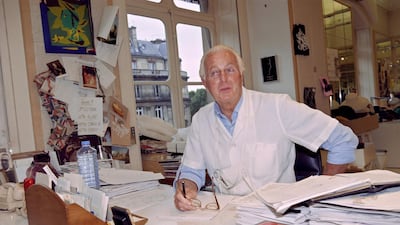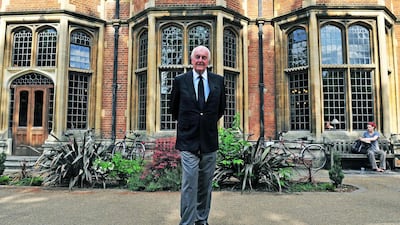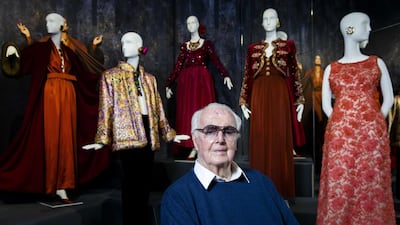Born in Beauvais, France, in 1927, Count Hubert James Marcel Taffin de Givenchy, grew to become a physically imposing man, standing at 6 feet and 6 inches, and possessed of striking good looks. Refined and sophisticated, he was drawn to the arts, first studying at École Nationale Supérieure des Beaux-Arts, then joining the studio of Jacques Fath and then, in 1947, Elsa Schiaparelli, and eventually becoming the style director of the House of Schiaparelli’s chic Place Vendôme boutique in Paris.
In 1952, he ventured out on his own, setting up an eponymous label that offered women the novel option of separates, which could be worn as chosen, rather than dictating how they must be worn. Free to express their own style, women flocked to Givenchy’s atelier, which was founded with the help of his friend and muse Bettina Graziani, who took on the role of his publicity director.
Already an established model, Graziani was tireless in ensuring the emerging designer received the attention she felt he was due. Described at the time by Life magazine, it was said Graziani "beat the publicity drums, pulled in all the important US fashion editors, posed for pictures, set up seats, pressed clothes backstage, modelled them on the runway and came out afterwards to sell them". Accordingly, Givenchy's first collection was named in her honour, while her name was immortalised in the label's signature ruffled blouse, the Bettina.
Givenchy shared his love for a pared-back aesthetic with his idol Cristóbal Balenciaga, who like Givenchy believed that purity of cut was the driving force behind good design. The pair were described as “undisputedly the world’s most prophetic designers”. Having met in 1954, the two men bonded and together came up with the chemise, or sack dress, described by the contemporary press as “a genuinely new shape in fashion”. Both designers were heralded with introducing new ideas and directions, with one actress crediting Givenchy as creating “quality clothes that combine simplicity with beauty”.
In 1953, Givenchy lent some pieces to actress Audrey Hepburn for her role in the film Sabrina, sparking a lifelong friendship that Hepburn later described as "like a kind of marriage". Bonded by a mutual love of understatement, she credited the designer as creating clothes "in which I feel myself. He is more than a designer; he is a creator of personality." In turn, he created the Sabrina neckline for her.

Givenchy dressed Hepburn for many of her roles, including Funny Face, and the now iconic black dress Hepburn wore in the opening sequence of Breakfast at Tiffany's. He later said that "the little black dress is the hardest thing to realise, because you must keep it simple".
He also dressed many other famous women, including Princess Grace of Monaco, Duchess of Windsor Wallis Simpson, Gloria Guinness, Bunny Mellon and Jacqueline Kennedy Onassis. As a sombre testament to the gravity of his pieces, when Jackie Kennedy buried her husband President John F Kennedy in 1963, she opted to wear a Givenchy design, as did the Duchess of Windsor when she attended her husband’s funeral in 1972. In 1988, when he was 61, Givenchy sold his label to the conglomerate LVMH for US$45 million, but remained as head of creative design until his retirement in 1995, saying of his departure that “life is like a book: one has to know when to turn the page”.

His departure was followed by a revolving door of British designers as replacement. First John Galliano was installed by LVMH chairman and chief executive Bernard Arnault, who then promptly moved him to Christian Dior just a year later. Galliano’s replacement was the 27-year-old Alexander McQueen in 1997, but despite his expertise in cutting – at which the house excelled – the partnership was never a happy one, and McQueen left in 2001 to set up his own label. Then came Julien Macdonald, who said of his debut autumn/winter couture show in 2001 that he “wanted to go back to classic ideals of Parisian elegance. Everyone remembers Hubert de Givenchy’s distinctive brand of sophistication.”
Producing elegant, but otherwise unchallenging collections, McDonald left in 2005. This opened the way for Riccardo Tisci who, over the next 12 years, reimagined and reinvigorated the house’s offerings. Like the founder, Tisci surrounded himself with famous and beautiful women, from whom he drew inspiration, while they became the living embodiment of Givenchy. For spring 2015, Tisci persuaded actress Julia Roberts to star – sans make-up and wearing a tuxedo – in his advertising campaign, while for autumn/winter the same year he used rival designer Donatella Versace as the star of his Tribute to Icons campaign. In 2016, Bella Hadid was made house muse, a year later, Tisci made Naomi Campbell the face of Givenchy Jeans, while his friendship with Kanye West and Kim Kardashian ensured his pieces were seen by millions.
Last year, however, Tisci announced his departure (he has now replaced Christopher Bailey at Burberry), at which point Arnault brought in Clare Waight Keller, the first woman to head the label. Coming from Chloé, Waight Keller is the only Givenchy designer to have actually met the label's founder, describing him as "the most charming man I have ever met".
While some would have been daunted to take over such a storied house, Waight Keller has embraced the challenge with gusto, producing collections that have been greeted with resounding accolades. Clearly inspired by the time spent with Givenchy himself, she has taken the label back to pieces that women desire, and are able to wear as they wish. On hearing of his passing, Waight Keller took to Instagram to express her deep respect and admiration for the designer. Describing her first unforgettable sighting of his work, in the opening scene of Breakfast at Tiffany's, she writes: "That simple but exquisite dress he designed became known as one of the most iconic little black dresses in history. A man of such grace and stature... he was a gentle genius in his understanding of the power of simplicity."
As one of the last great designers of the golden age of couture, Hubert de Givenchy was, no doubt, in his prime during the 1950s and 1960s, alongside the other giants of fashion, such as Balenciaga, Christian Dior and Yves Saint Laurent. Such is his legacy that, despite retiring from fashion in 1995, Givenchy’s name is still synonymous with elegant simplicity and powerful understatement. His clothes are known to speak rather than shout, and offer quiet sophistication, crafted from sparsity of cut.
With only a few names left from the heady times of Givenchy’s heyday, his passing marks the end of an era. However, at his death, the label that still carries his name released a statement that paid homage to his timeless skill and vision. Describing Givenchy as an unrivalled personality in the world of French haute couture and a symbol of Parisian elegance for more than half a century, it reads: “His approach to fashion and his influence remains as relevant today as it has always been.”
____________________
Read more:
This Dh7.85 million watch is dedicated to Sheikh Zayed
Why Tiffany Haddish's Oscar outfit is so important for the Eritrean diaspora
____________________
















